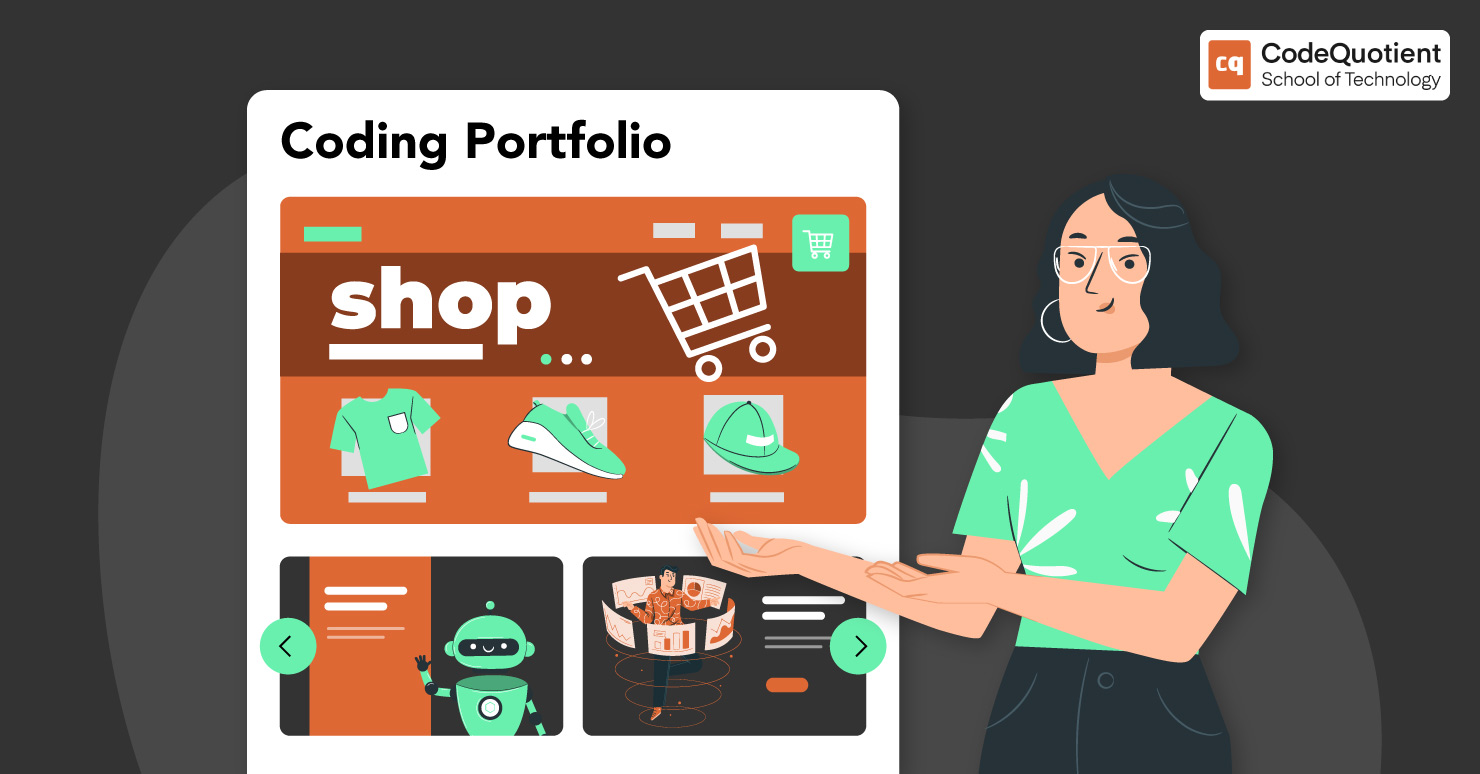As a student, having a strong coding portfolio is essential for launching your career in software development or computer science. This portfolio allows you to vividly demonstrate abilities you have developed through coursework and personal projects.
While you may not have extensive professional experience yet, an outstanding portfolio that showcases your existing skills can capture the attention of potential employers. We’ll guide you through building a portfolio that highlights your talents to give you an edge as an aspiring developer.
What Is a Coding Portfolio?
A coding portfolio is a collection of code samples, projects, and other materials that demonstrate your programming skills and experience. Unlike a standard resume, which simply lists qualifications, a portfolio allows you to provide direct evidence of your abilities as a developer. This gives employers more insight into what you can achieve.
Why Do You Need a Coding Portfolio?
Simply having a computer science degree is not enough to land most developer roles in today’s highly competitive environment. Submitting a traditional resume alone leaves too much room for doubt about whether you can perform in the role.
Hiring managers want concrete proof that you possess the right blend of hard and soft skills. This is precisely what an impressive coding portfolio provides.
By vividly demonstrating concepts you understand and abilities you have acquired, an outstanding portfolio achieves three things:
- Makes a Strong First Impression: Visual evidence of your capabilities excites recruiters and gets you to the top of the candidate list.
- Stands Out in a Competitive Job Market: Real examples of your work differentiate you from the crowd.
- Demonstrates Practical Application of Skills: Working demos prove you can code and deliver tangible products.
In essence, your portfolio serves as a dynamic extension of your resume, providing irrefutable evidence that you walk the talk. This instil confidence in recruiters that you can be productive from day one.
What Should You Include in Your Portfolio?

Crafting a well-rounded coding portfolio requires thoughtful curation of projects that highlight both your technical prowess and soft skills. While there is no rigid template to follow, most impressive portfolios include the key elements below:
1. Domain Name
Having your own domain lends credibility and a professional touch. Options like myname.com and firstnamelastname.com work well.
2. Design and Format
Opt for a clean, uncluttered layout that makes navigation intuitive. Employers will be visiting your site on all devices, so ensure your portfolio is easily viewable and navigable across mobiles, tablets and desktops.
3. “About Me” Section
Give a snapshot of your background, strengths, achievements and career aspirations. However, keep it crisp and engaging instead of a vague ramble.
For example:

4. Featured Projects
As a student, carefully curate 3-5 academic, freelance, or personal projects that align with the roles you are targeting. For each project, describe the specific contributions you made, integrations implemented, challenges overcome, and value delivered. This proves you can apply coding skills practically.
You can also showcase coursework like advanced data structures and algorithms implementations. Discuss associated technical concepts on a dedicated “Blog” page to provide insight into your coding journey.
While you likely don’t have career growth to demonstrate yet, you can highlight increasing complexity in academic coursework and independent projects over time. This shows progression in your abilities.
5. Highlight Technical and Soft Skills
Throughout your portfolio, demonstrate both coding expertise in languages like Java, Python, JavaScript, etc, as well as soft skills like creativity, communication and time management. This creates a holistic picture of what you bring to the table.
6. Contact Details
Prominently highlight multiple contact options like email address, LinkedIn profile, GitHub account, online resume, etc. This facilitates recruiters in reaching out effortlessly.
How Can You Make Your Portfolio Stand Out?
With stellar portfolios becoming the norm today, you need to go the extra mile to make recruiters sit up and take notice. Try these tips:
1. Refine Your Code
Scrub your code samples thoroughly to eliminate any bad coding practices that could raise red flags. Adhere to style guides and optimisation best practices to take your coding standards to the next level.
2. Add Explainers
Supplement your projects with blog-style explainers describing vital technical concepts, why you chose certain frameworks, challenges faced, etc. This provides invaluable insight into your development journey.
Here is an example of adding a compelling explainer to supplement a project in your portfolio:
![]()
3. Link Your Portfolio with Social Platforms
Integrate your portfolio domain with your LinkedIn and GitHub accounts to improve the visibility of projects with the developer community. On LinkedIn, share posts explaining portfolio projects or concepts learned through coursework to demonstrate coding knowledge.
On GitHub, committing code frequently signals coding consistency essential for recruiters evaluating student developers based on limited information. Utilise these platforms synergistically with your portfolio to multiply impact.
4. Create a Clean and User-Friendly Layout
Well-organised navigation menus, uncluttered pages, prominent calls-to-action and rich visuals enhance both aesthetics and usability for exceptional user experience.
What Are Employers Looking for in a Coding Portfolio?
A portfolio should showcase a few essential aspects of your coding career. Recruiters want to see a smooth progression from your start to your current status. Keep your portfolio updated with your latest work, showing that you stay up to date in your field.
- Your portfolio should also reflect your career growth. Show how you have taken on more complex projects or moved up in your roles.
- Besides your achievements, your education matters too. Include any degrees or certificates that are relevant to coding, such as from a coding boot camp.
- Finally, your portfolio should highlight your problem-solving abilities. Show how you have applied your technical skills to real-world situations and overcome the difficulties you faced.
What Mistakes Should You Avoid When Building Your Portfolio?
While errors in functionality or design can be overcome, strategic mistakes are harder to remedy. Avoid these pitfalls that create lasting negative impressions:
1. Overloading With Irrelevant Information
Showcase only your best work aligned to the specific job role. Inundating employers with periphery projects and tangential skills will only dilute the impact.
2. Neglecting Design and Layout
Shabby or disorganised portfolios project the image of a sloppy developer. Remember, your portfolio represents you.
3. Failing to Update and Maintain Your Coding Portfolio
As you learn new languages and frameworks, complete additional projects, and evolve as a developer through your academic work, regularly enhance your portfolio. This shows commitment to continuous skill building critical for a successful coding career.
For example, if you learned React this semester, create a new React project to showcase. Update code samples to reflect evolving technical prowess. Enriching your portfolio demonstrates a development discipline that recruiters will appreciate.
Ready to build an exceptional portfolio?
A stellar coding portfolio is instrumental for students embarking on promising technology careers. Beyond exhibiting your proficiency in languages like HTML, CSS and JavaScript, an outstanding portfolio also offers recruiters a window into your development process through explainers and videos.
An outstanding portfolio greatly accelerates your chances of securing your dream coding job. So start handpicking impressive projects today and develop an incredible coding portfolio that kick-starts your journey to career success!
For expert guidance on building a portfolio aligned with your career goals, check out CodeQuotient School of Technology. Our purpose-driven programs offer comprehensive mentoring on projects tailored to your target industry.
Contact us today for more details on how you can build an exceptional coding portfolio!




